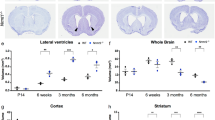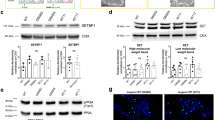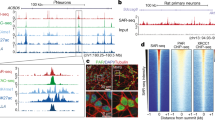Abstract
Defective responses to DNA single strand breaks underlie various neurodegenerative diseases. However, the exact role of this repair pathway during the development and maintenance of the nervous system is unclear. Using murine neural-specific inactivation of Xrcc1, a factor that is critical for the repair of DNA single strand breaks, we found a profound neuropathology that is characterized by the loss of cerebellar interneurons. This cell loss was linked to p53-dependent cell cycle arrest and occurred as interneuron progenitors commenced differentiation. Loss of Xrcc1 also led to the persistence of DNA strand breaks throughout the nervous system and abnormal hippocampal function. Collectively, these data detail the in vivo link between DNA single strand break repair and neurogenesis and highlight the diverse consequences of specific types of genotoxic stress in the nervous system.
This is a preview of subscription content, access via your institution
Access options
Subscribe to this journal
Receive 12 print issues and online access
$209.00 per year
only $17.42 per issue
Buy this article
- Purchase on Springer Link
- Instant access to full article PDF
Prices may be subject to local taxes which are calculated during checkout








Similar content being viewed by others
References
McKinnon, P.J. DNA repair deficiency and neurological disease. Nat. Rev. Neurosci. 10, 100–112 (2009).
McKinnon, P.J. & Caldecott, K.W. DNA strand break repair and human genetic disease. Annu. Rev. Genomics Hum. Genet. 8, 37–55 (2007).
Rass, U., Ahel, I. & West, S.C. Defective DNA repair and neurodegenerative disease. Cell 130, 991–1004 (2007).
Ahel, I. et al. The neurodegenerative disease protein aprataxin resolves abortive DNA ligation intermediates. Nature 443, 713–716 (2006).
El-Khamisy, S.F. et al. Defective DNA single-strand break repair in spinocerebellar ataxia with axonal neuropathy-1. Nature 434, 108–113 (2005).
Moreira, M.C. et al. The gene mutated in ataxia-ocular apraxia 1 encodes the new HIT/Zn-finger protein aprataxin. Nat. Genet. 29, 189–193 (2001).
Takashima, H. et al. Mutation of TDP1, encoding a topoisomerase I–dependent DNA damage repair enzyme, in spinocerebellar ataxia with axonal neuropathy. Nat. Genet. 32, 267–272 (2002).
Tebbs, R.S. et al. Requirement for the Xrcc1 DNA base excision repair gene during early mouse development. Dev. Biol. 208, 513–529 (1999).
Tallquist, M.D. & Soriano, P. Epiblast-restricted Cre expression in MORE mice: a tool to distinguish embryonic vs. extra-embryonic gene function. Genesis 26, 113–115 (2000).
Caldecott, K.W. DNA single-strand break repair and spinocerebellar ataxia. Cell 112, 7–10 (2003).
Frappart, P.O., Lee, Y., Lamont, J. & McKinnon, P.J. BRCA2 is required for neurogenesis and suppression of medulloblastoma. EMBO J. 26, 2732–2742 (2007).
Shull, E.R. et al. Differential DNA damage signaling accounts for distinct neural apoptotic responses in ATLD and NBS. Genes Dev. 23, 171–180 (2009).
Caldecott, K.W., McKeown, C.K., Tucker, J.D., Ljungquist, S. & Thompson, L.H. An interaction between the mammalian DNA repair protein XRCC1 and DNA ligase III. Mol. Cell. Biol. 14, 68–76 (1994).
Kulkarni, A., McNeill, D.R., Gleichmann, M., Mattson, M.P. & Wilson, D.M.,, III. XRCC1 protects against the lethality of induced oxidative DNA damage in nondividing neural cells. Nucleic Acids Res. 36, 5111–5121 (2008).
Rogakou, E.P., Pilch, D.R., Orr, A.H., Ivanova, V.S. & Bonner, W.M. DNA double-stranded breaks induce histone H2AX phosphorylation on serine 139. J. Biol. Chem. 273, 5858–5868 (1998).
Sedelnikova, O.A., Pilch, D.R., Redon, C. & Bonner, W.M. Histone H2AX in DNA damage and repair. Cancer Biol. Ther. 2, 233–235 (2003).
Barmack, N.H. & Yakhnitsa, V. Functions of interneurons in mouse cerebellum. J. Neurosci. 28, 1140–1152 (2008).
Sillitoe, R.V. & Joyner, A.L. Morphology, molecular codes and circuitry produce the three-dimensional complexity of the cerebellum. Annu. Rev. Cell Dev. Biol. 23, 549–577 (2007).
Eccles, J.C. Neurogenesis and morphogenesis in the cerebellar cortex. Proc. Natl. Acad. Sci. USA 66, 294–301 (1970).
Weisheit, G. et al. Postnatal development of the murine cerebellar cortex: formation and early dispersal of basket, stellate and Golgi neurons. Eur. J. Neurosci. 24, 466–478 (2006).
Watanabe, D. et al. Ablation of cerebellar Golgi cells disrupts synaptic integration involving GABA inhibition and NMDA receptor activation in motor coordination. Cell 95, 17–27 (1998).
Englund, C. et al. Unipolar brush cells of the cerebellum are produced in the rhombic lip and migrate through developing white matter. J. Neurosci. 26, 9184–9195 (2006).
Yamanaka, H., Yanagawa, Y. & Obata, K. Development of stellate and basket cells and their apoptosis in mouse cerebellar cortex. Neurosci. Res. 50, 13–22 (2004).
Weyer, A. & Schilling, K. Developmental and cell type–specific expression of the neuronal marker NeuN in the murine cerebellum. J. Neurosci. Res. 73, 400–409 (2003).
Rakic, P. Kinetics of proliferation and latency between final cell division and onset of differentiation of cerebellar stellate and basket neurons. J. Comp. Neurol. 147, 523–546 (1973).
Lee, A. et al. Isolation of neural stem cells from the postnatal cerebellum. Nat. Neurosci. 8, 723–729 (2005).
Kenney, A.M. & Segal, R.A. Subtracting the Math: prominin-positive cerebellar stem cells in white matter. Nat. Neurosci. 8, 699–701 (2005).
Zhang, L. & Goldman, J.E. Generation of cerebellar interneurons from dividing progenitors in white matter. Neuron 16, 47–54 (1996).
Maricich, S.M. & Herrup, K. Pax-2 expression defines a subset of GABAergic interneurons and their precursors in the developing murine cerebellum. J. Neurobiol. 41, 281–294 (1999).
Lee, Y. & McKinnon, P.J. Responding to DNA double strand breaks in the nervous system. Neuroscience 145, 1365–1374 (2007).
Lee, Y. & McKinnon, P.J. DNA ligase IV suppresses medulloblastoma formation. Cancer Res. 62, 6395–6399 (2002).
Orii, K.E., Lee, Y., Kondo, N. & McKinnon, P.J. Selective utilization of nonhomologous end-joining and homologous recombination DNA repair pathways during nervous system development. Proc. Natl. Acad. Sci. USA 103, 10017–10022 (2006).
Lumpkin, E.A. et al. Math1-driven GFP expression in the developing nervous system of transgenic mice. Gene Expr. Patterns 3, 389–395 (2003).
McNamara, J.O., Huang, Y.Z. & Leonard, A.S. Molecular signaling mechanisms underlying epileptogenesis. Sci. STKE 2006, re12 (2006).
Aronica, E. & Gorter, J.A. Gene expression profile in temporal lobe epilepsy. Neuroscientist 13, 100–108 (2007).
Morgan, J.I., Cohen, D.R., Hempstead, J.L. & Curran, T. Mapping patterns of c-fos expression in the central nervous system after seizure. Science 237, 192–197 (1987).
Frappart, P.O. & McKinnon, P.J. Ataxia-telangiectasia and related diseases. Neuromolecular Med. 8, 495–511 (2006).
Goldowitz, D. & Hamre, K. The cells and molecules that make a cerebellum. Trends Neurosci. 21, 375–382 (1998).
Wang, V.Y. & Zoghbi, H.Y. Genetic regulation of cerebellar development. Nat. Rev. Neurosci. 2, 484–491 (2001).
Sotelo, C. Cellular and genetic regulation of the development of the cerebellar system. Prog. Neurobiol. 72, 295–339 (2004).
Leto, K., Carletti, B., Williams, I.M., Magrassi, L. & Rossi, F. Different types of cerebellar GABAergic interneurons originate from a common pool of multipotent progenitor cells. J. Neurosci. 26, 11682–11694 (2006).
Kastan, M.B. & Bartek, J. Cell-cycle checkpoints and cancer. Nature 432, 316–323 (2004).
Glickstein, S.B. et al. Selective cortical interneuron and GABA deficits in cyclin D2–null mice. Development 134, 4083–4093 (2007).
Huard, J.M., Forster, C.C., Carter, M.L., Sicinski, P. & Ross, M.E. Cerebellar histogenesis is disturbed in mice lacking cyclin D2. Development 126, 1927–1935 (1999).
Howell, O.W. et al. Neuropeptide Y is important for basal and seizure-induced precursor cell proliferation in the hippocampus. Neurobiol. Dis. 26, 174–188 (2007).
Baraban, S.C. Neuropeptide Y and epilepsy: recent progress, prospects and controversies. Neuropeptides 38, 261–265 (2004).
Caldecott, K.W. XRCC1 and DNA strand break repair. DNA Repair (Amst.) 2, 955–969 (2003).
Soutoglou, E. & Misteli, T. Activation of the cellular DNA damage response in the absence of DNA lesions. Science 320, 1507–1510 (2008).
Hatten, M.E. Neuronal regulation of astroglial morphology and proliferation in vitro. J. Cell Biol. 100, 384–396 (1985).
Katyal, S. et al. TDP1 facilitates chromosomal single-strand break repair in neurons and is neuroprotective in vivo. EMBO J. 26, 4720–4731 (2007).
Acknowledgements
We thank the Hartwell Center for biotech support, the Transgenic core facility for blastocyst injections, the Animal Imaging core for magnetic resonance imaging analysis and J. Zhao for genotyping. P.J.M. is supported by the US National Institutes of Health (NS-37956 and CA-21765), the Cancer Center Support Grant (P30 CA21765) and the American Lebanese and Syrian Associated Charities of St. Jude Children's Research Hospital. K.W.C. is supported by the Medical Research Council (Grants G0600776 & G0400959) and by the European Union Integrated Project on DNA Repair. S.K. is a Neoma Boadway AP Endowed Fellow and S.F.E.-K. is supported by the Wellcome Trust (Grant 085284).
Author information
Authors and Affiliations
Contributions
Y. Lee and S.K. performed all experiments characterizing the Xrcc1-deficient mouse and contributed to writing the manuscript. Y. Li and H.R.R. generated the mouse model and were responsible for colony production and maintenance with assistance from S.K. and Y. Lee. S.F.E.-K. and K.W.C. designed and performed experiments and contributed to preparation of the manuscript. P.J.M. was project leader and produced the final version of the manuscript.
Corresponding author
Supplementary information
Supplementary Text and Figures
Supplementary Figures 1–12 and Supplementary Table 1 (PDF 1859 kb)
Supplementary Movie 1
Xrcc1 movie. (MOV 5122 kb)
Rights and permissions
About this article
Cite this article
Lee, Y., Katyal, S., Li, Y. et al. The genesis of cerebellar interneurons and the prevention of neural DNA damage require XRCC1. Nat Neurosci 12, 973–980 (2009). https://doi.org/10.1038/nn.2375
Received:
Accepted:
Published:
Issue Date:
DOI: https://doi.org/10.1038/nn.2375
This article is cited by
-
Deficient DNA base-excision repair in the forebrain leads to a sex-specific anxiety-like phenotype in mice
BMC Biology (2022)
-
XRCC1 protects transcription from toxic PARP1 activity during DNA base excision repair
Nature Cell Biology (2021)
-
Persistent DNA damage triggers activation of the integrated stress response to promote cell survival under nutrient restriction
BMC Biology (2020)
-
DNA repair deficiency in neuropathogenesis: when all roads lead to mitochondria
Translational Neurodegeneration (2019)
-
DNA single-strand break-induced DNA damage response causes heart failure
Nature Communications (2017)



